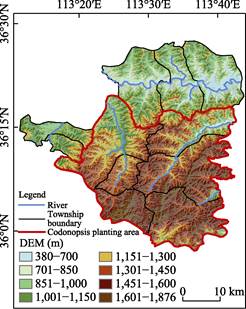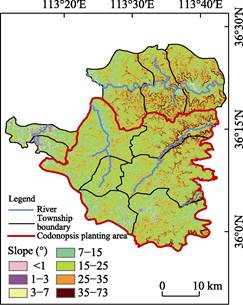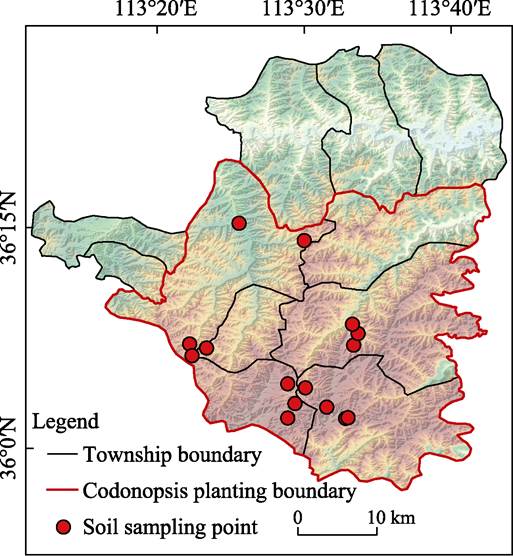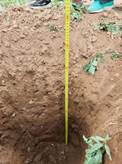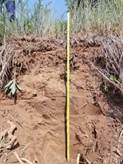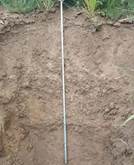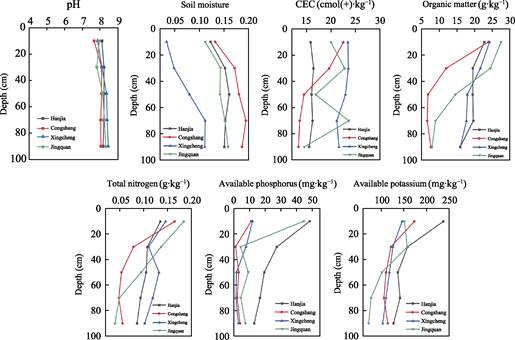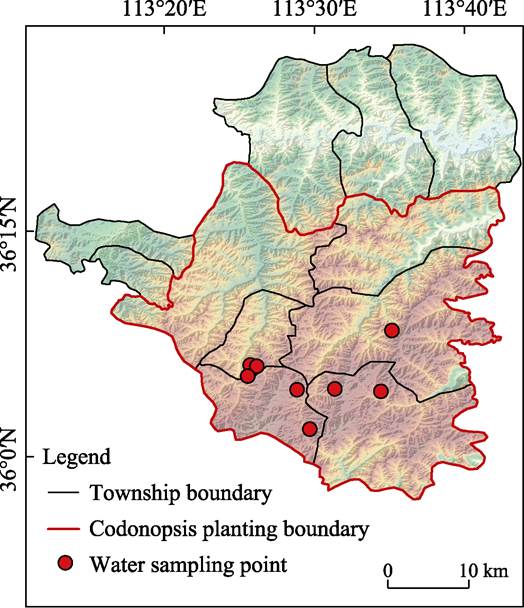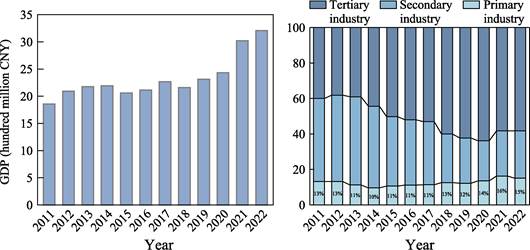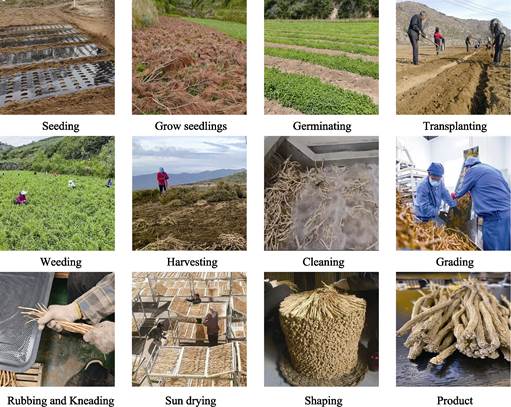Pingshun Lu Dangshen (Codonopsis pilosula)
Abstract
Pingshun County, situated in the southern Taihang Mountains, bordering the Shangdang Basin, Changzhi City, Shanxi Province of China. Pingshun is characterized by middle mountainous terrain and features a warm temperate semi-humid continental monsoon climate with distinct seasons, simultaneous rainfall and heat, significant day-night temperature differences, and an annual sunshine duration of 2,783 hours, making it famous for its abundant cultivation of Codonopsis pilosula. The soil is slightly alkaline. The growth of Codonopsis pilosula depends on natural precipitation. Ping Shun has a long history of Codonopsis pilosula, which is rich in medicinal function. In 2023, Pingshun County had a population of 148,100 and a GDP of 32.1 billion CNY, with Codonopsis pilosula cultivation covering 17.73 km2, producing 2,940 tons valued at 2.94 billion CNY. The case dataset on Pingshun Codonopsis pilosula consists of: (1) boundary data; (2) physical geography data (including topography, climate, water, soil, land use, and NDVI); (3) characteristic data of Codonopsis pilosula; (4) operation and management data; and (5) socioeconomic data. This dataset was archived in .xlsx, .shp, .tif, .jpg, .txt, and .docx formats and consisted of 93 data files with a data size of 156 MB (compressed into one file with 69.8 MB).
Introduction
With the development of socioeconomic status and improved living standards, the demand for a higher quality of life has increased, leading to the emergence of “geographical indication products”. Codonopsis pilosula, with its sweet taste, neutral nature, and effects of human bodies, is a traditional medicinal herb in China that holds a significant position in the field of traditional Chinese medicine[1-3]. Codonopsis pilosula resources are widely distributed and have a long history of cultivation. Historical herbal documents have noted that the finest Codonopsis pilosula originates from the Shangdang region of Shanxi, specifically in the Pingshun, Huguan, and Lingchuan surrounding the areas in Changzhi, Shanxi[4,5]. Pingshun County is situated in the southern section of the Taihang Mountains in Shanxi at the convergence of the Shanxi, Hebei, and Henan provinces. Its unique geographical location and atmospheric circulation conditions have led to the cultivation of a geographically distinctive indication product, Pingshun Codonopsis pilosula[6,7].
Codonopsis pilosula cultivation in Pingshun County demonstrates notable regional characteristics. With the widespread application and adoption of advanced production technologies, the quality of Codonopsis pilosula has markedly improved. Consequently, industrialization and recognition have gradually increased, making it a focal point for economic development in Pingshun County. This study leverages the GIES cases[8-10] to develop a series of dataset, aiming to provide solid evidence about how high-quality it is and how keeping it beautiful[11-13].
Metadata of the Dataset
The metadata for the case study is summarized in Table 1[14]. This includes the full name, short name, authors, year of the dataset, data format, data size, data files, data publisher, and data-sharing policies.
Table 1 Metadata Summary of the GIES case dataset on pingshun Codonopsis pilosula southern Taihang Mountain
| Items | Description | ||
|---|---|---|---|
| Dataset full name | GIES case dataset on Pingshun Codonopsis pilosula southern Taihang Mountain | ||
| Dataset short name | PingshunCodonopsispilosulaCase22 | ||
| Authors | Zhang, H., Shanxi University, zhanghong@sxu.edu.cn Li, X. M., Pingshun County Agriculture and Rural Bureau, 494061993@qq.com Wang, Y. S., Institute of Geographic Sciences and Natural Resources Research, Chinese Academy of Sciences Zhang, X. Y., Shanxi University, zhang_xyhz@sxu.edu.cn Su, C., Shanxi University, suchao@sxu.edu.cn Jia, C. D., Pingshun County Agriculture and Rural Bureau, psxxncbgs@126.com Zhan, H. X., Shanxi University of Chinese Medicine, zhan030006@126.com Hou, W. Y., Shanxi Zhenglai Pharmaceutical Co., Ltd. 710107766@qq.con Zhao, X. L., Shanxi Jinshangu Agricultural Technology Co., Ltd. 273413503@qq.com Zhou, Y. F., Pingshun Shangdang Chinese Medicinal Materials Specialized Town, Pingshun, 1129718033@qq.com Liu, C., Institute of Geographic Sciences and Natural Resources Research, Chinese Academy of Sciences, lchuang@igsnrr.ar.cn | ||
| Geographical region | Pingshun County, 35°56′37″N–36°27′44″N, 113°11′45″E–113°44′04″E | ||
| Year | 2024 | ||
| Data format | .xlsx, .shp, .tif, .jpg, .txt, .docx | ||
| Data size | 156 MB (69.8 MB compressed) | ||
| Data files | The case dataset includes:(1) Boundary data; (2) Physical geography data (including topography, climate, water, soil, land use, and NDVI); (3) Characteristic data of Codonopsis pilosula; (4) Operation and management data; (5) Socioeconomic data | ||
| Foundation | Pingshun County Agriculture and Rural Bureau (SXMY2024-1118) | ||
| Data publisher | Global Change Research Data Publishing & Repository, http://www.geodoi.ac.cn | ||
| Address | No. 11A, Datun Road, Chaoyang District, Beijing 100101, China | ||
| Data sharing policy | (1) Data are openly available and can be free downloaded via the Internet; (2) End users are encouraged to use Data subject to citation; (3) Users, who are by definition also value-added service providers, are welcome to redistribute Data subject to written permission from the GCdataPR Editorial Office and the issuance of a Data redistribution license; and (4) If Data are used to compile new datasets, the ‘ten per cent principal’ should be followed such that Data records utilized should not surpass 10% of the new dataset contents, while sources should be clearly noted in suitable places in the new dataset[15] | ||
| Communication and searchable system | DOI, CSTR, Crossref, DCI, CSCD, CNKI, SciEngine, WDS, GEOSS, PubScholar, CKRSC |
DOI: https://doi.org/10.3974/geodp.2024.03.06
CSTR: https://cstr.escience.org.cn/CSTR:20146.14.2024.03.06
Dataset Availability Statement:
The dataset supporting this paper was published and is accessible through the Digital Journal of Global Change Data Repository at: https://doi.org/10.3974/geodb.2024.12.02.V1 or https://cstr.escience.org.cn/CSTR: 20146.11.2024.12.02.V1.
Data and Methodology
The data developed from the case study were derived from remote-sensing imagery, maps, official statistics, and field measurements. Based on natural geographic features, such as terrain, climate, land use, soil, and hydrology, during the growth and cultivation process of the case product, Pingshun Codonopsis pilosula, a scientific evaluation of the ecological environment and product quality in the case area was conducted. This study also analyzed the history, status, and future development of Codonopsis pilosula cultivation, providing a scientific basis for promoting the sustainable development of the Codonopsis pilosula industry in Pingshun County. The main data sources are as follows.
(1) Vector boundary data[1] were sourced from the Chinese Township Administrative Boundary Data provided by the Institute of Geographic Sciences and Natural Resources Research, Chinese Academy of Sciences. These data were used to extract the boundary between Pingshun County and towns where Codonopsis pilosula was cultivated.
(2) DEM data: Sourced from SRTM elevation data[2]. The data were cropped, and slope calculations and classifications were performed.
(3) Meteorological data: Temperature, precipitation, evapotranspiration, sunshine hours, and wind speed data were sourced from the National Basic Meteorological Station (Station No. 53888). Annual and monthly averages were calculated.
(4) Soil, surface water, and Codonopsis pilosula indicator data were sourced from field sampling and sample testing conducted in June 2024.
(5) Land use data based on Sentinel-2 satellite imagery. The land-use categories were classified based on band composition, cropping, delineation of sample regions, supervised classification, result comparison, and fine-tuning steps. The land-use areas and proportions were statistically analyzed using ArcGIS, providing an overview of land use in Pingshun County.
(6) Economic and population data: Shanxi Provincial Statistical Yearbook[3]. Planting area data were obtained from the agricultural statistics of Pingshun County.
Study Area Data
Pingshun County is located in the southeastern part of Shanxi Province in the eastern region of Changzhi City. It lies in the southern section of the Taihang Mountains, bordering Shexian County in Hebei Province and Linzhou City in Henan Province. The county extends from 113°11ʹ45ʺE to 113°44ʹ04ʺE and from 35°56ʹ37ʺN to 36°27ʹ44ʺN. It spans approximately 53 km from north to south and 45 km from east to west, covering a total area of 1,550 km2. The county governs 11 towns: Qingyang, Longxi, Shicheng, Miaozhuang, Yuxiaguan, Xigou, Dongsitou, Hongtiguan, Yanggao, Beidanche, and Bieshe. The county has a total area of 486.87 km2 dedicated to cultivating traditional Chinese medicinal herbs. Among this, the planting area of Codonopsis pilosula (a type of ginseng) spans 17.73 km2, primarily concentrated in Longxi Town, Yuxiaguan Town, Qingyang Town, Dongsitou Township, Hongtiguan Township, and Xigou Township. Over 70 key villages engage in the cultivation of Codonopsis pilosula.
Ecological Data
Topography
Pingshun County is located in the southern section of the Taihang Mountains at the edge of the Shangdang Basin. The terrain is lower in the northwest and higher in the southeast. The western region, close to the edge of the basin, consists mostly of plateaus, whereas the central area is hilly. The landscape has been transformed into rugged mountains and ridges in the southeast. The elevation of Pingshun County ranges from 380 to 1,876 m, with the highest point located at Fengziling in Yuxiaguan Town and the lowest point at the outlet of the Zhuozhang River in Shicheng Town (Figure 2). The county is crisscrossed by four rivers: the Zhuozhang, Hongni, Shizi, and Jingdi. The Zhuozhang River flows through the northern regions of Pingshun County, specifically Beidanche Township, Yanggao Township, and Shicheng Town. The research area was primarily concentrated in six townships in Pingshun County: Yuxiaguan, Longxi, Qingyang, Dongsitou, Xigou, and Hongtiguan. Mountainous regions with elevations ranging from 1,000 to 1,600 m and slopes less than 25° are the principal cultivation zones for Codonopsis pilosula ginseng (Figure 3).
Climatic Data
Pingshun County has a warm, temperate, semi-humid continental monsoon climate characterized by the simultaneous occurrence of heat and rainfall, which is highly conducive to agricultural development. According to data from the Pingshun County Meteorological Station within the national meteorological monitoring network, the average annual temperature in the area is 9.8 °C, and the average annual precipitation is 600 mm. Rainfall is distinctly seasonal, with the majority concentrated in the summer; spring and winter receive relatively less precipitation (Figure 4, 5). The average annual wind speed was 1.9 m/s, and the average annual evaporation rate was 1,631.6 mm. The prevailing wind direction is from the southwest, and the frost-free period spans 120–210 d. The accumulated temperature above 10 °C throughout the year ranges from 2,700 to 3,800 °C, with the total annual sunshine hours reaching 2,783. The mild and cool climate, along with favorable altitude, precipitation, and ecological conditions, combined with the mountainous terrain of the region, creates optimal conditions for the cultivation of high-quality Codonopsis pilosula. In particular, the relatively low average temperature during summer, significant diurnal temperature variation, and extended daylight hours further enhanced the conversion of photosynthetic products and the accumulation of active ingredients, such as polysaccharides, in Codonopsis pilosula.
| Figure 4 Precipitation and premature of Pingshun County (yearly, 2010–2019) | Figure 5 Precipitation and premature of Pingshun County (average monthly) |
|---|---|
 |
|
Soil Data
Surface Soil
Brown soil is a characteristic soil of Pingshun County that typically exhibits a neutral to mildly alkaline reaction. It is loose, well-drained, and rich in humus, making it highly suitable for cultivating Codonopsis pilosula. Surface soil in the study area was sampled and tested. A total of 14 sampling points were mainly located in Yuxiaguan Town, Qingyang Town, Dongsitou Township, Longxi Town, and Xigou Township (Figure 6). The sampling depth was 0–20 cm. This study tested the environmental quality and fertility of the collected surface soil samples[16,17]. The assessment of soil nutrient status included cation exchange capacity, organic matter, total nitrogen, available phosphorus, and rapid potassium. In contrast, the soil environmental quality assessment included pH, water content, and Cd, Hg, As, Pd, Cr, Cu, Ni, and Zn[18].
The results of the analysis of surface soil samples in the study area are presented in Table 2. Soil moisture ranged from 3.33% to 17.80%, with a mean of 10.73%. The soil pH ranged from 5.68 to 8.10, with an average of 7.57. The soil cation exchange capacity (CEC), organic matter content, nitrogen content, available phosphorus, and available potassium ranged from 13.49 to 25.22 cmol(+)/kg, 10.62 to 30.79 g/kg, 0.7 to 2.01 g/kg, 7.8 to 53 mg/kg, and 137.35 to 373.39 mg/kg, respectively. The average values were 19.34 cmol (+)/kg、22.26 g/kg, 1.43 g/kg, 26.68 mg/kg, and 192.55 mg/kg, indicating abundant surface soil nutrients.
The results of the heavy metal content in the surface soil samples from the study area are shown in Table 3 and Figure 7. The content of heavy metals Hg, Cr, Ni, Cu, Zn, As, Cd, and Pd in surface soil ranged from 0.01 to 0.04, 29.17 to 86.89, 13.11 to 41.57, 10.04 to 34.28, 30.57 to 91.39, 5.96 to 18.13, 0.08 to 0.22, and 8.24 to 26.56 mg/kg, respectively. The average values were 0.02, 69.68, 33.21, 26.20, 72.44, 14.68, 0.17, and 20.39 mg/kg. Comparison to Soil Environmental Quality Risk Control Standard for Soil Contamination of Agricultural Land (GB 15618—2018)[19]. All the detection indicators were far below the soil pollution risk screening values, meeting the environmental standards for agricultural land.
Table 2 Statistics of surface soil fertility indices in the case area
| Sampling site | pH | Moisture content (%) | CEC (cmol(+)/kg) | Organic matter (g/kg) | Nitrogen content (g/kg) | Available phosphorus (mg/kg) | Available potassium (mg/kg) |
|---|---|---|---|---|---|---|---|
| Xincheng Village | 7.10 | 11.93 | 25.22 | 23.56 | 1.41 | 25.50 | 160.55 |
| Hanjia Village | 8.10 | 12.26 | 15.84 | 22.73 | 1.35 | 53.00 | 237.10 |
| LaomalingVillage | 7.77 | 8.22 | 20.95 | 19.21 | 1.28 | 8.95 | 137.35 |
| Dihe Village | 7.69 | 13.39 | 18.11 | 20.47 | 1.16 | 20.88 | 145.75 |
| Anyang Village | 7.52 | 10.01 | 16.61 | 30.79 | 2.01 | 39.10 | 330.35 |
| Congshang Village | 7.66 | 13.21 | 22.53 | 23.86 | 1.65 | 12.00 | 172.89 |
| Xingcheng Village | 7.86 | 3.33 | 23.45 | 24.20 | 1.46 | 12.80 | 145.96 |
| Xiaosai Village | 7.82 | 17.80 | 17.45 | 20.19 | 1.46 | 48.30 | 373.39 |
| Jingquan Village | 7.95 | 11.19 | 20.01 | 27.42 | 1.84 | 46.50 | 151.08 |
| Zhaocheng Village | 5.68 | 10.47 | 21.92 | 19.57 | 1.43 | 26.95 | 156.19 |
| Dongsitou Village | 7.86 | 10.68 | 13.49 | 10.62 | 0.70 | 26.20 | 163.90 |
| Jingquan Village | 7.70 | 7.56 | 22.27 | 27.17 | 1.55 | 7.80 | 176.39 |
| Menlou Village | 7.67 | 8.16 | 16.90 | 15.87 | 1.10 | 34.00 | 168.54 |
| Heihu Village | 7.63 | 12.11 | 15.82 | 26.07 | 1.70 | 11.55 | 176.28 |
| Minimum | 7.10 | 3.33 | 13.49 | 10.62 | 0.70 | 7.80 | 137.35 |
| Maximum | 8.10 | 17.8 | 25.22 | 30.79 | 2.01 | 53.00 | 373.39 |
| Mean | 7.57 | 10.73 | 19.32 | 22.26 | 1.43 | 26.68 | 192.55 |
| Standard deviation | 0.59 | 3.33 | 3.48 | 5.16 | 0.33 | 14.72 | 72.04 |
Table 3 Statistics of heavy metal concentrations of surface soil in the case area
| Sampling site | Hg (mg/kg) | Cr (mg/kg) | Ni (mg/kg) | Cu (mg/kg) | Zn (mg/kg) | As (mg/kg) | Cd (mg/kg) | Pb (mg/kg) |
|---|---|---|---|---|---|---|---|---|
| Xincheng Village | 0.03 | 86.89 | 41.57 | 34.28 | 89.81 | 18.13 | 0.18 | 26.56 |
| Hanjia Village | 0.03 | 71.63 | 33.89 | 31.71 | 91.39 | 15.60 | 0.22 | 20.56 |
| Laomaling Village | 0.02 | 79.76 | 37.32 | 27.38 | 78.02 | 17.48 | 0.16 | 21.46 |
| Dihe Village | 0.03 | 72.67 | 34.83 | 29.56 | 70.47 | 14.47 | 0.18 | 21.94 |
| Anyang Village | 0.02 | 29.17 | 13.11 | 10.04 | 30.57 | 5.96 | 0.08 | 8.24 |
| Congshang Village | 0.02 | 74.26 | 36.43 | 27.14 | 74.02 | 16.45 | 0.20 | 24.08 |
| Xingcheng Village | 0.04 | 74.79 | 36.84 | 29.88 | 76.98 | 17.06 | 0.19 | 22.37 |
| Xiaosai Village | 0.03 | 62.34 | 28.93 | 23.23 | 69.44 | 13.24 | 0.17 | 19.07 |
| Jingquan Village | 0.02 | 76.73 | 38.22 | 31.83 | 85.83 | 16.07 | 0.20 | 21.11 |
| Zhaocheng Village | 0.02 | 71.52 | 34.72 | 28.10 | 76.92 | 14.93 | 0.15 | 20.98 |
| Dongsitou Village | 0.01 | 64.81 | 29.47 | 21.37 | 62.80 | 12.99 | 0.14 | 17.77 |
| Jingquan Village | 0.01 | 71.79 | 33.88 | 24.48 | 70.83 | 15.43 | 0.18 | 21.26 |
| Menlou Village | 0.02 | 71.70 | 32.90 | 24.27 | 73.93 | 14.82 | 0.17 | 19.87 |
| Heihu Village | 0.03 | 67.53 | 32.79 | 23.51 | 63.15 | 12.97 | 0.18 | 20.19 |
| Minimum | 0.01 | 29.17 | 13.11 | 10.04 | 30.57 | 5.96 | 0.08 | 8.24 |
| Maximum | 0.04 | 86.89 | 41.57 | 34.28 | 91.39 | 18.13 | 0.22 | 26.56 |
| Risk screening value | 3.44 | 250 | 190 | 100 | 300 | 25 | 0.60 | 170 |
| Mean | 0.02 | 69.68 | 33.21 | 26.20 | 72.44 | 14.68 | 0.17 | 20.39 |
| Standard deviation | 0.01 | 13.13 | 6.67 | 5.98 | 14.84 | 2.99 | 0.03 | 4.09 |
Deep Soil
In this study, four deep soil sampling sites were established in Yuxiaguan Town, Xigou Township, and Longxi Town to investigate the deep soil conditions in Pingshun County (Figure 8). The soil profile was 1.2 m in length, 1.0 m in width, and 1.0 m in depth. Soil profile excavation ensured the observation surface was oriented toward the sun. The profile was meticulously leveled and smoothed, and rough surfaces were eliminated to prevent visible tool marks. Photographs of the profiles and distinctive features were obtained according to the protocol. Soil samples were collected from five layers at 20 cm interval from each profile to assess the fertility conditions and environmental status of the deep soil in the Codonopsis pilosula cultivation area. The testing parameters were aligned with those used for the surface soil.
Analysis of deep soil samples indicated significant variations in soil pH and moisture content at different depths. The average pH and moisture content of the 0–20 cm soil layer was 7.88% and 10%, respectively. As depth increased, soil pH and moisture content increased, with soil at 80–100 cm reaching pH values of 8.23% and moisture content of 15.16%, respectively (Figure 9). The range of soil CEC in the case study area varies from 13.36 to 23.62 cmol(+)/kg, with the highest levels observed in the 0–20 cm soil layer, averaging at 20.45 cmol(+)/kg. As the depth increased, the soil fertility capacity decreased, with the average soil CEC in the 80–100 cm layer measuring 16.27 cmol(+)/kg, a phenomenon attributed to the soil formation processes in the case study area. In the studied area, the range of soil organic matter, total nitrogen, available phosphorus, and rapidly available potassium is between 6.60–27.42 g/kg, 0.4–1.84 g/kg, 1.1–48.5 mg/kg, and 72.19– 237.29 mg/kg, respectively. Analysis of various sampling points revealed that the contents of organic matter, total nitrogen, available phosphorus, and rapidly available potassium in the top 0–20 cm soil layer were relatively high, with average values of 24.55 g/kg, 1.57 g/kg, 29.05 mg/kg, and 176.75 mg/kg, respectively. Moreover, as the depth increased, the concentration of organic matter, total nitrogen, available phosphorus, and available potassium decreased. Particularly, the soil at a depth of 80–100 cm exhibits the lowest levels of these soil nutrients, with average values of 11.85 g/kg, 0.71 g/kg, 6.81 mg/kg, and 104.31 mg/kg, respectively.
The concentration of heavy metals, including Hg, Cr, Ni, Cu, Zn, As, Cd, and Pb, were measured in soils at various depths. The ranges observed were 0.01–0.06, 64.25–82.23, 29.19–40.46, 20.98–31.83, 59.40–91.39, 12.85–17.23, 0.12–0.22, and 16.80– 26.03 mg/kg, respectively. The concentrations of these heavy metals decreased with increasing soil depth. Importantly, the heavy metal concentrations in the tested soils were significantly lower than the limits for soil contamination risks, indicating compliance with the environmental standards established for agricultural purposes.
Water Quality
This study involved water sampling and analysis of the case area. Three surface water samples were collected from Shangjing, Xiajing, and Congshang villages; three rainwater samples were collected from Dongzhang, Xincheng, and Heihu villages; and two groundwater samples were obtained from Shimenkou and Menlou villages (Figure 10). In accordance with the basic control parameters outlined in the “Standards for Irrigation Water Quality” (GB 5084—2021)[20]and the “Standard for Groundwater Quality” (GB/T 14848—2017)[21], the following factors were analyzed: pH, water temperature, chloride, sulfide, chemical oxygen demand (COD), anionic surfactants, and heavy metals including Cu, Zn, Pd, Ni, Cr, Hg, As, and Cd. 14 parameters were tested in this study.
The water quality test results for the study area are listed in Table 5. The surface water and rainwater temperatures in the area ranged from 25.41 °C to 26.4 °C, with pH between 7.56 and 8.30, indicating weak alkalinity. The concentrations of chloride, sulfide, COD, and anionic surfactants in the water ranged from 1.27 to 15.39 mg/L, 0.01 to 0.05 mg/L, 4.51 to 18.68 mg/L, and 0.07 to 0.11 mg/L, respectively. The levels of heavy metals, including Cu, Zn, Pd, Ni, Cr, As, and Hg, ranged from 0.00 to 0.09 mg/L, 0.089 to 0.460 mg/L, 0.00 to 0.01 mg/L, 0.00 to 0.17 mg/L, 0.00 to 0.08 mg/L, 0.001 to 0.01 mg/L, and 0.000,024 to 0.000,22 mg/L, respectively. Cd was not detected. All surface water parameters were within acceptable limits and complied with the “Standards for Irrigation Water Quality”(GB 5084—2021)[20] for dryland crops. The groundwater quality results (Table 4) showed that all parameters fell within the standard limits, meeting the Class I criteria specified in the “Standard for Groundwater Quality”(GB/T 14848—2017)[21].
Table 4 Statistics of water quality in the case area
| Item | Standard for irrigation water quality | Surface water | Rainwater | Groundwater | Standards for groundwater | |||||
|---|---|---|---|---|---|---|---|---|---|---|
| (≤) | W1 | W2 | W3 | W4 | W5 | W6 | W7 | W8 | (≤) | |
| pH | 6–9 | 8.30 | 7.78 | 8.23 | 7.56 | 8.14 | 7.76 | 8.16 | 8.35 | 6.5–8.5 |
| Water Temperature (°C) | 35 | 26.40 | 26.40 | 26.20 | 25.78 | 26.78 | 25.41 | 9.75 | 8.94 | — |
| Chloride (mg/L) | 350 | 4.84 | 5.10 | 1.27 | 12.42 | 15.39 | 13.45 | 1.34 | 3.67 | 50 |
| Sulfide (mg/L) | 1 | 0.01 | 0.01 | 0.01 | 0.04 | 0.05 | 0.02 | 0.000 | 0.001 | 0.005 |
| COD (mg/L) | 200 | 9.03 | 12.04 | 4.51 | 12.00 | 13.74 | 18.68 | 0.453 | 0.565 | 1 |
| Anionic Surfactant (mg/L) | 0.3 | 0.11 | 0.09 | 0.07 | 0.01 | 0.01 | 0.01 | 0.000 | 0.000 | Not detectable |
| Total Mercury (mg/L) | 1 | 0.090 | 0.080 | 0.080 | 0.002 | 0.001 | 0.000 | 0.001 | 0.005 | 0.01 |
| Total Zinc (mg/L) | 2 | 0.390 | 0.460 | 0.430 | 0.130 | 0.136 | 0.089 | 0.044 | 0.024 | 0.05 |
| Total Lead (mg/L) | 0.1 | 0.010 | 0.010 | 0.010 | 0.000 | 0.000 | 0.000 | 0.000 | 0.000 | 0.005 |
| Total Nickel (mg/L) | 0.2 | 0.070 | 0.170 | 0.080 | 0.000 | 0.001 | 0.000 | 0.000 | 0.000 | 0.002 |
| Chromium (Hexavalent) (mg/L) | 0.1 | 0.060 | 0.080 | 0.050 | 0.002 | 0.001 | 0.000 | 0.001 | 0.001 | 0.005 |
| Total Mercury (ug/L) | 1 | 0.170 | 0.180 | 0.200 | 0.198 | 0.024 | 0.220 | 0.027 | 0.062 | 0.1 |
| Total Arsenic (mg/L) | 0.1 | 0.010 | 0.010 | 0.010 | 0.001 | 0.001 | 0.002 | 0.000 | 0.000 | 0.001 |
| Total Cadmium (mg/L) | 0.01 | 0.000 | 0.000 | 0.000 | 0.000 | 0.000 | 0.000 | 0.000 | 0.000 | 0.000,1 |
Notes: W1 Congshang Village; W2 Shangjing Village; W3 Xiajing Village; W4 Dongzhang Village; W5 Xincheng Village; W6 Heihu Village; W7 Shimenkou Village; W8 Menlou Village.
Land Use
Pingshun County exhibits six primary land-use categories: cultivated land, forests, grasslands, water bodies, urban areas, and vacant land (Figure 11). The largest land category was forests, covering 60.20% of the total area, making it the predominant land type in the county, and mainly located in the central and northern regions. Grassland accounted for 18.78%, followed by cultivated land at 17.07%, construction land at 3.59%, and water areas at 0.36%. Grasslands are predominantly found in the southwest and southeast of Pingshun County, whereas cultivated land is primarily situated in the southern part and the foothills of gently sloping mountains. Most artificially cultivated Codonopsis pilosula are grown on cultivated land, whereas wild Codonopsis pilosula thrive in forests.
Characteristics of Codonopsis pilosula in Pingshun County
Codonopsis pilosula samples were collected from Yuxiaguan Town, Longxi Town, and Dongsitou Township in Pingshun County. Codonopsis oral solution was supplied by Shanxi Zhenglai Pharmaceutical Co. Ltd. This study analyzed the levels of syringin, lobetyolin, atractylenolide III, polysaccharide, and ethanol extract as well as the heavy metals Pb, Cd, Hg, Cu, and As in both Codonopsis pilosula samples and oral solution. Additionally, the pesticide residue levels of buprofezin, carbendazim, cidial, and pyraclostrobin were assessed[22].
The detection results for the components of the Codonopsis pilosula samples are listed in Table 5. The syringin, lobetyolin, atractylenolide III, polysaccharide, and ethanol extracts of Codonopsis pilosula ranged from 0.038 to 0.057 mg/g, 0.429 to 1.041 mg/g, 0.068 to 0.088 mg/g, 133.081 to 177.680 mg/g, and 78.95% to 82.32%, with average values of 0.046 mg/g, 0.626 mg/g, 0.076 mg/g, 159.158 mg/g, and 81.38%, respectively. Codonopsis pilosula oral solution was developed using Codonopsis pilosula as the raw material, with syringin, lobetyolin, atractylenolide III, and polysaccharide contents reaching 0.091, 0.162, 0.047, and 1,440.82 mg/mL, indicating rich medicinal value.
The concentrations of heavy metals and pesticide residues were shown in Table 6. The contents of Pb, Cd, Hg, Cu, and As in the Codonopsis pilosula samples range from 0.374 to 0.792, 0.044 to 0.111, 0.004 to 0.008, 6.96 to 9.41, and 0.358 to 0.752 mg/kg, respectively. meeting the requirements outlined in the “Green Trade Standards of Importing and Exporting of Medicinal Plants and Preparations”[23]. Buprofezin was found to be 0.002 mg/kg, while Carbendazim ranged from 0.001 to 0.004 mg/kg. Cidium and pyraclostrobin were not detectable in the samples. The pesticide residue content in Codonopsis pilosula from the study area were significantly lower than the standard limits.
Table 5 Statistics of medicinal composition of Codonopsis pilosula in the case area
| Sample Number | Syringin (mg/g) | Lobetyolin (mg/g) | Atractylenolide III (mg/g) | Polysaccharide (mg/g) | Ethanol extracts (%) |
|---|---|---|---|---|---|
| 1 | 0.057 | 1.041 | 0.088 | 177.680 | 82.32 |
| 2 | 0.050 | 0.661 | 0.081 | 166.323 | 82.30 |
| 3 | 0.044 | 0.515 | 0.074 | 164.070 | 82.19 |
| 4 | 0.040 | 0.483 | 0.070 | 154.636 | 81.14 |
| 5 | 0.038 | 0.429 | 0.068 | 133.081 | 78.95 |
| Mean±standard deviation | 0.046±0.008 | 0.626±0.027 | 0.076±0.008 | 159.158±16.726 | 81.38%±1.45 |
| Codonopsis pilosula oral solution (mg/mL) | 0.091 | 0.162 | 0.047 | 1,440.82 | — |
Table 6 Statistics of heavy metals and pesticide residues concentrations in Codonopsis pilosula samples
| Sample Number | Heavy metals (mg/kg) | Pesticide residue indicators (mg/kg) | |||||||
|---|---|---|---|---|---|---|---|---|---|
| Pd | Cd | Hg | Cu | As | Buprofezin | Carbendazim | Cidial | Pyraclostrobin | |
| 1 | 0.374 | 0.044 | 0.008 | 9.41 | 0.358 | 0.002 | 0.001 | — | — |
| 2 | 0.414 | 0.055 | 0.004 | 8.74 | 0.361 | 0.002 | 0.003 | — | — |
| 3 | 0.792 | 0.111 | 0.007 | 6.96 | 0.752 | 0.002 | 0.001 | — | — |
| 4 | 0.601 | 0.052 | 0.005 | 9.19 | 0.606 | 0.002 | 0.004 | — | — |
| 5 | 0.414 | 0.055 | 0.004 | 8.74 | 0.361 | 0.002 | 0.003 | — | — |
| Codonopsis pilosula oral solution (mg/L) | 0.045 | 0.002 | 0.001 | 0.154 | 0.091 | 0.002 | 0.001 | — | — |
| Standard limit | 5 | 0.3 | 0.2 | 20 | 2 | 0.05 | 0.05 | 0.05 | 0.05 |
Socio-economic and Business Management of Pingshun County
Socio-economic Status of Pingshun County
The GDP of Pingshun County increased from 18.55 billion CNY in 2011 to 32.05 billion CNY in 2022 (Figure 12), demonstrating a consistent upward trend. The composition of value added from primary, secondary, and tertiary industries in Pingshun County’s GDP has significantly changed over the past 12 years. The proportion of value added from the primary sector rose from 13% to 15%, while the share of value added from the tertiary industry increased from 40% to 58%. Notably, the production value of Codonopsis pilosula contributed 34.19% to the value added by the primary sector in Pingshun County. Pingshun County strategically aligns with the province and city’s transformation and leapfrog development agendas, seizing growth opportunities within the Central Plains Economic Zone and Shanxi Province’s comprehensive reform trial zone. The county aims to establish itself as a premier national tourism destination, a modern industrial park, and a nationally recognized ecological construction demonstration area known as the “one district and two zones”. By the end of 2023, the county had a total of 5.56 million households and a registered population of 148,100.
History and Tranditional Culture of Codonopsis pilosula in Pingshun County
Pingshun County has a long-standing tradition and rich heritage of the cultivation of Codonopsis pilosula. The term “Codonopsis pilosula” is derived from “Shangdang Codonopsis pilosula” which was later abbreviated to “Codonopsis pilosula”. During the Qin Dynasty, parts of Changzhi, Jincheng, and Jinzhong counties were incorporated into the Shangdang Commandery, from which Shangdang Codonopsis pilosula was named. During the Tang Dynasty, the area was renamed Luzhou. As a result, Codonopsis pilosula became known as Lu Codonopsis pilosula, which is still in use. According to “Lu An Fu Zhi”, Codonopsis pilosula is found in the Shangdang eastern mountains, indicating that Codonopsis pilosula is primarily cultivated in the southeastern mountainous regions of Shangdang[24]. Qing Dynasty scholar Wu, Yiluo further affirmed this, stating in his book “Ben Cao Cong Xin”, “Codonopsis pilosula from Shangdang is the best,” solidifying the region of ancient Lu Zhou (Shanxi) as the authentic source of Codonopsis pilosula[3,25].
Since the early 21st century, Pingshun County has prioritized Codonopsis pilosula cultivation as a key initiative, widely promoting its planting. The county has obtained GAP (Good Agricultural Practices) certification for Codonopsis pilosula and has developed various production bases. Through the “company+base+farmers” model, Pingshun has advanced the standardized and regulated production of Codonopsis pilosula. Pingshun Codonopsis pilosula was officially recognized as a geographical indication product in 2011, and received a national geographical indication certification in 2020. Pingshun County established the national unique native habitat protection zone for Codonopsis pilosula in 2020. Pingshun Codonopsis pilosula base was selected as one of the first national “Three Products and One Standard” bases for agricultural planting in 2021, Pingshun County was designated “Shangdang Traditional Chinese Medicine Special Town” in 2022, Codonopsis pilosula cultivation system in Changzhi, Shanxi Province was listed among Chinese Important Agricultural Heritage Systems by the Ministry of Agriculture and Rural in 2023. By placing Codonopsis pilosula at the forefront, Pingshun County nurtured the traditional Chinese medicinal herb industry, expanded its industrial chain, enhanced technological support, and improved product quality and branding.
Cultivation and Processing Management of Codonopsis pilosula
Planting and Field Management
Codonopsis pilosula is a deep-rooted tap-rooted plant that thrives in deep, loose, well-drained soil and is rich in humus (typically sandy loam). Codonopsis pilosula is commonly rotated with leguminous crops, tubers, and cereal crops, with a rotation cycle generally lasting more than 3 years. The sowing of Codonopsis pilosula typically occurs between late April and early May. After preparing the land, the seeds were broadcasted and lightly covered with a thin layer of soil. To create favorable conditions for seedling emergence, the ground is shaded using shade nets, pine branches, straw, or bean stubble, as seedlings prefer shaded environments. Once the seedlings appeared, coverage was gradually reduced to a light transmission rate of approximately 15%. When the seedlings reached a height of 10 cm, the covering was steadily removed, typically over 3–5 d, to prevent sunburn. During this time, intertillage and weeding were conducted, and herbicides were strictly prohibited (Figure 13)[26].
Before transplanting, the field should be leveled, and drainage ditches should be prepared based on the topography of the land. Transplantation is typically performed from late March to early April of the following year. Before transplanting, organic fertilizer was applied to the selected field, and furrows were dug at a row spacing of 15–25 cm. Seedlings were placed in furrows with a spacing of 8–10 cm, and covered with soil. After transplantation, weeding was performed once the seedlings were well established. The first weeding was performed in mid-late May, followed by monthly weeding thereafter. When the seedlings reached a 20–30 cm height, additional organic fertilizer was applied. The water requirements of Codonopsis pilosula are primarily met by natural rainfall, making artificial irrigation unnecessary[27]. However, during the rainy season, field drainage should be carefully monitored. From late June to mid-July, during Codonopsis pilosula’s vigorous growth phase, the top 15 cm of stems are pruned (topping), usually performed twice. Once the flowering buds appear, they must be promptly removed[28].
Harvesting and Storage
The harvest of Codonopsis pilosula typically takes place in autumn. Harvesting should not occur too early; waiting until the aboveground stems and leaves have fully withered and turned yellow is important. If harvested prematurely, the movement of nutrients from the aerial parts to the underground roots may be disrupted, negatively affecting root yield and quality. Harvesting was performed on both dry and sunny days. First, any support was removed, and the vine-like stems were cut off. Next, on one side of the bed, a 30 cm deep trench was dug using a hoe or machinery, and the roots were carefully extracted. Special care should be taken to avoid damaging or breaking the roots, as this could cause the white sap to leak out, which would lower the quality of the roots. Once the roots are excavated, they should be thoroughly washed to remove any soil and then sorted into three grades based on the root diameter at the base: Grade 1 (≥ 0.9 cm), Grade 2 (0.6–0.9 cm), and Grade 3 (0.4–0.6 cm), along with a mixed category for those of varying sizes[25]. The roots were then air-dried to ensure they were not exposed to excessive moisture, which could have caused mold. Storing or handling roots near toxic, harmful, corrosive, odorous, or volatile substances is strictly prohibited, as this could compromise the quality of Codonopsis pilosula.
Product Processing
The Codonopsis pilosula roots should be processed by gentle rubbing once they have dried to softness[28]. Approximately 10 roots are typically bundled into small bunches and then carefully rubbed by hand from the root tip to the base 5 to 6 times. It is important to avoid applying excessive force during the process. After shaping, the roots were sun-dried for an additional 1–2 d. The rubbing and drying process was repeated approximately thrice to ensure that the skin and wood were closely bound, resulting in straight roots, tightly adhered skin and flesh, and a smooth, soft texture. Codonopsis pilosula should be shaped into its final form during the final rubbing. Once the desired shape was achieved, the roots were sorted according to the grade.
The Codonopsis pilosula Industry in Pingshun County
Government Helps Revitalize the Medicinal Herbs Industry
Government support is the strongest guarantee for the sustainable development of Pingshun’s traditional Chinese medicine industry. In recent years, Pingshun County has introduced a series of preferential policies to support the development of the traditional Chinese medicine industry, including “Decision on Accelerating the High-Quality Development of Traditional Chinese Medicine Industry” and “Measures to Promote the Healthy Development of the Pharmaceutical Industry in Pingshun County”. Initiatives encompass creating a national modern agricultural industrial park, establishing Shangdang specialized towns for traditional Chinese medicinal materials, establishing the unique Codonopsis pilosula native habitat conservation area and Codonopsis pilosula germplasmresource garden in China, and constructing Shangdang Traditional Chinese Medicinal Materials Incubation Center and Codonopsis pilosula Exhibition Hall. In addition, platforms such as Northern Medicine Local Medicinal Material Trading, Traditional Chinese Medicinal Material Quality Testing, Online Information Sharing, and Scientific Research and Innovation have been established in Pingshun.
Science and Technology Contribute to the Codonopsis pilosula Industry Parks and Town
Pingshun County has increased its research investment in the traditional Chinese medicine industry by collaborating with various universities and research institutes. This university-industry partnership has resulted in the development of a range of products, including Codonopsis pilosula oral solution, stir-frying millet and Codonopsis pilosula, Codonopsis pilosula paste and Codonopsis pilosula leaf tea. Furthermore, the establishment of Shangdang Traditional Chinese Medicinal Materials Industry Research Institute, the formation of the Chinese Medicine Innovation and Research Development Alliance, the creation of expert and doctoral workstations, the development of specialized biological fertilizers for Codonopsis pilosula, and the attainment of over 10 research accomplishments, such as the production of a specialized bio-fertilizer for Codonopsis, have been notable achievements. Additionally, more than 20 practical technologies have been disseminated, and the “New Farmer” program has been implemented to nurture individuals skilled in technology, business management, and operational aspects within the traditional Chinese medicinal materials.
Digital Intelligence Facilitates the Advancement of E-commerce in the Medicinal Herbs Industry
Pingshun County established a robust digital platform to promote the sale of traditional Chinese medicinal materials and enhance product value. They developed the Taihang e-commerce town, introduced the Alibaba Group to build an AI artificial intelligence big data labeling base, and signed a strategic cooperation agreement with the Alibaba Rural Revitalization Fund to jointly build “Pingshun Shangdang Chinese Medicinal Materials Specialized Town”. This collaboration has facilitated the expansion of Pingshun Chinese medicinal material products to major online platforms such as Taobao, JD.com, and Douyin. They have actively organized e-commerce training, promoted farmers to become live streamers, and transformed rural areas into microbusiness villages, establishing 15 microbusiness villages and 150 rural e-commerce service sites. By 2022, the county’s e-commerce network retail sales will reach 280 million Yuan, benefiting 51,000 farmers through e-commerce development.
Cultural Tourism Fosters the Growth of the Medicinal Herbs Industry
Pingshun County is actively developing the “Traditional Chinese Medicine + Cultural Tourism” industry, creating a deep integration of Chinese medicine research and education, medicinal cuisine, and tourism. The county has established the Chinese Medicinal Herb Cultural Park and Codonopsis pilosula Popular Science Experience Base, allowing visitors to explore the rich history and culture of traditional Chinese medicinal materials. Visitors can immerse themselves in planting, cultivating, and harvesting these valuable herbs, promoting a new model of “advancing medicine through tourism and advancing tourism through medicine.” This initiative injects fresh vitality into rural revitalization, contributing to sustainable development in the region.
Discussion and Conclusion
Pingshun County is located in the southern Taihang Mountains at the edge of the Shangdang Basin. The entire region belongs to a central mountainous area with elevations ranging from 380 to 1,876 m. The terrain is rugged with high mountains and deep valleys, and a warm temperate semi-humid continental monsoon climate characterizes the region. The four seasons are distinct, with rainfall and heat occurring simultaneously, making it suitable for the growth of Codonopsis pilosula. The surface water and soil in the planting areas were mildly alkaline, and the regional ecological environment was superior and pollution-free. This unique geographical environment nurtures the production of high-quality Codonopsis pilosula products. Pingshun Codonopsis pilosula is rich in beneficial components such as polysaccharides, syringin, and atractylenolide III, which have high medicinal value. To ensure the high-quality development of Pingshun Codonopsis pilosula in the future, the following measures can be taken. (1) Strengthen ecological protection efforts: continue to protect and improve the region’s soil quality and water resources, and provide a high-quality environmental environment for the growth and planting of Codonopsis pilosula. (2) Enhancement of standardized production management: Ensure that the quality of Codonopsis pilosula does not decline and maintains consistent product quality. (3) Promote the integration of primary, secondary, and tertiary industries: expand the industrial chain of Codonopsis pilosula, increase the added value of the industrial chain, and promote the integrated development of medicine and tourism. (4) Coordinate information flow, logistics, and human resources: Achieve collaborative efforts across all aspects of production, improve production efficiency, and ensure the sustainability of the production process. The research “GIES Case Study on Pingshun Codonopsis pilosula in the Southern Taihang Mountain” provides more scientific, efficient, and sustainable planting techniques and management experience for the cultivation of Codonopsis pilosula. This will further enhance the yield and quality of Codonopsis pilosula, increase farmers’ incomes, and promote the protection of the Codonopsis pilosula habitat as a regional landmark for sustainable development.
References
[1] Chinese Pharmacopoeia Commission. Pharmacopoeia of the People’s Republic of China [M]. Beijing: China Medical Science Press, 2020: 293–294.
[2] Feng, Y. J., Wang, X. X., Zhuang, P. Y., et al. Study on chemical constituents of Codonopsis pilosula [J]. China Journal of Chinese Materia Medica, 2017, 42(1): 135–139.
[3] Feng, P. P, Li, Z. X., Yuan, Z., et al. Review on the phytochemical and pharmacological study of Codonopsis Genus [J]. Journal of Shenyang Pharmaceutical University, 2012, 29(4): 307–311.
[4] Lan, X. Y., Zhou L., Li X., et al. Research progress of traditional Chinese medicine Codonopsis Radix and prediction of its Q-markers [J]. China Journal of Chinese Materia Medica, 2023, 48(8): 2020–2040.
[5] Wu, X. J. Research on zoning based on the quality of Codonopsis pilosula medicinal materials [D]. Hangzhou: Zhejiang Chinese Medical University, 2018.
[6] Gao, K., Lin, H. Y. Research progress ongenuine Chinese medicinal materials in Shanxi [J]. Journal of Shanxi Agricultural Sciences, 2023, 51(12): 1457–1467.
[7] Qiu, D. Y., Ma, L., Wu, R., et al. Preliminary analysis on the quality differences of Codonopsis pilosula from different origins [J]. Lishizhen Medicine and Materia Medica Research, 2023, 34(9): 2232–2236.
[8] Liu, C., Guo, X. Y., Liu, Y. H., et al. Gies case dataset on summer angling and winter fishing in Panshi Qiantang (thousands of reservoirs), Jilin province of China [J]. Journal of Global Change Data & Discovery, 2021, 5(4): 385–398.
[9] Liu, C., Yu, X. H., Sun, Y. W., et al. Summary report of the 1st Symposium on GI Environment and Sustainability [J]. Journal of Global Change Data & Discovery, 2021, 5(1): 108.
[10] Wang, Y. S., Yang, Y. Y., Liu, Y. S., et al. GIEs case dataset on Yangxian black rice crested ibis (nipponia nippo) habitat in Caoba Village, Shaanxi Province of China [J]. Journal of Global Change Data & Discovery, 2021, 5(3): 290–299.
[11] Wang, Z. X. Summary report of the 2 show cases symposium on GI environment and sustainability [J]. Journal of Global Change Data & Discovery, 2021, 5(1): 109.
[12] Song, X. F., Yu, J. Q., Qi, W., et al. GIEs case dataset on Panshi Qiantang (thousands reservoirs) rice in permanent farmland, Jilin province of China [J]. Journal of Global Change Data & Discovery, 2022, 6(2): 157–168.
[13] Liu, C., Gong, K., Liu, Y. H., et al. An innovative solution on geographical indications for environment & sustainability (GIEs) [J]. Journal of Global Change Data & Discovery, 2021, 5(3): 237–248.
[14] Zhang, H., Li, X. M., Wang, Y. S., et al. GIES Case Dataset on Pingshun Codonopsis pilosula SouthernTaihang Mountain [J/DB/OL]. Digital Journal of Global Change Data Repository, 2024. https://doi.org/10.3974/geodb.2024.12.02.V1. https://cstr.escience.org.cn/CSTR:20146.11.2024.12.02.V1.
[15] GCdataPR Editorial Office. GCdataPR data sharing policy [OL]. https://doi.org/10.3974/dp.policy.2014.05 (Updated 2017).
[16] Zhang, Z. Q., Wang, K., Song, W., et al. GIES case study on Feng county pear of the ancient Yellow River floodplain [J]. Journal of Global Change Data & Discovery, 2023, 7(2): 129–147.
[17] Tan, W. F., Li, L. S., Yang, X. L., et al. GIES case dataset on Suining sweet potato subtropical hills in Qingfeng Village, Baima Town, Sichuan Province of China [J]. Journal of Global Change Data & Discovery, 2022, 6(2): 169–179.
[18] State Environmental Protection Administration. Technical specification for soil environmental monitoring (HJ/T 166—2004) [S]. Beijing: China Environmental Science Press, 2004.
[19] Ministry of Ecology and Environment of the P. R. China, State Administration for Market Regulation. Soil environmental quality risk control standard for soil contamination of agricultural land (Trial) (GB 15618—2018) [S]. Beijing: China Environment Publishing Group, 2018.
[20] Ministry of Ecology and Environment of the People’s Republic of China, State Administration for Market Regulation. Standard for irrigation water quality (GB 5084—2021) [S]. Beijing: China Environment Publishing Group, 2021.
[21] General Administration of Quality Supervision, Inspection and Quarantine of the P. R. China, National Standardization Administration. Standard for groundwater quality (GB/T14848—2017) [S]. Beijing: Standards Press of China, 2017.
[22] Lan, X. Y., Tian, C. F., Zhan, Z. L., et al. Comparison of wild and cultivated Codonopsis pilosula based on traditional quality evaluation [J]. Chinese Journal of Experimental Traditional Medical Formulae, 2024, 30 (14): 156–164.
[23] Ministry of Commerce of the People’s Republic of China. Green trade standards of importing and exporting of medicinal plants and preparations [S]. Beijing: Standards Press of China, 2001.
[24] Pingshun County Local Chronicle Compilation Committee. Pingshun County Chronicle [M]. Beijing: Haichao Publishing House, 1997.
[25] Wang, Y. F. Research on the propagation system of Codonopsis pilosula and investigation of superior strains [D]. Beijing: China Union Medical University, 2010.
[26] Pingshun County Local Specialty Development Association. Local Logo Products Pingshun Codonopsis pilosula (T/PXTC 0003—2022) [S]. Pingshun County People’s Government, 2022. https://xueshu.baidu. com/usercenter/paper/show?paperid=122q04x0yb610es00j3g0p30f3124798&site=xueshu_se.
[27] Pingshun County Local Specialty Development Association. Pingshun Lu Codonopsis cultivation tech-nical regulations (T/PXTC 0002—2021) [S]. Pingshun County People’s Government, 2021. https://xueshu.baidu.com/usercenter/paper/show?paperid=162w0vd0m33y0jj0xb2f02d0pr457477&site=xueshu_se.
[28] Changzhi Quality and Technical Supervision Bureau. Technical regulations for the production of green agricultural product Codonopsis pilosula (DB 1404/T 026—2018) [S]. People’s Government of Chang- zhi City, Shanxi Province, 2018. https://nyncj.changzhi.gov.cn/lssj/czny/spyb/201901/W020190104336962450554.pdf.
Case Team
Author Contributions
Zhang, H. and Liu, C. designed the overall framework for this case study and organized a workshop to discuss the case in detail. Zhang, H., Liu, C., Wang, Y. S., Zhang, X. Y., Su, C., Zhan, H. X., Hou, W. Y. and Zhao, X. L. took part in the fieldwork of the case study, contributing with statistical data, soil analyses, and enterprise management insights. Zhang, X. Y. assisted in completing the remote sensing image processing and cartographic tasks. Su, C. and Zhan, H. X. helped provided valuable assistance in conducting the analysis of sample and revising the manuscript. Li, X. M., Hou, W. Y., Zhao, X. L. and Zhou, Y. F. completed the collection of samples and the construction of the base.
Acknowledgements
Assisting in the on-site investigation of the case include Pingshun County Development, Reform and Science and Technology Bureau, Pingshun County Agriculture and Rural Bureau, Pingshun Shangdang Chinese Medicinal Materials Specialized Town, Heihu Village Codonopsis pilosula Popular Science Experience Base, Congshang Village Codonopsis pilosula Planting Demonstration Base, Shanxi Zhenglai Pharmaceutical Co., Ltd. and Shanxi Jinshangu Agricultural Technology Co., Ltd., The author also expresses deep gratitude.

